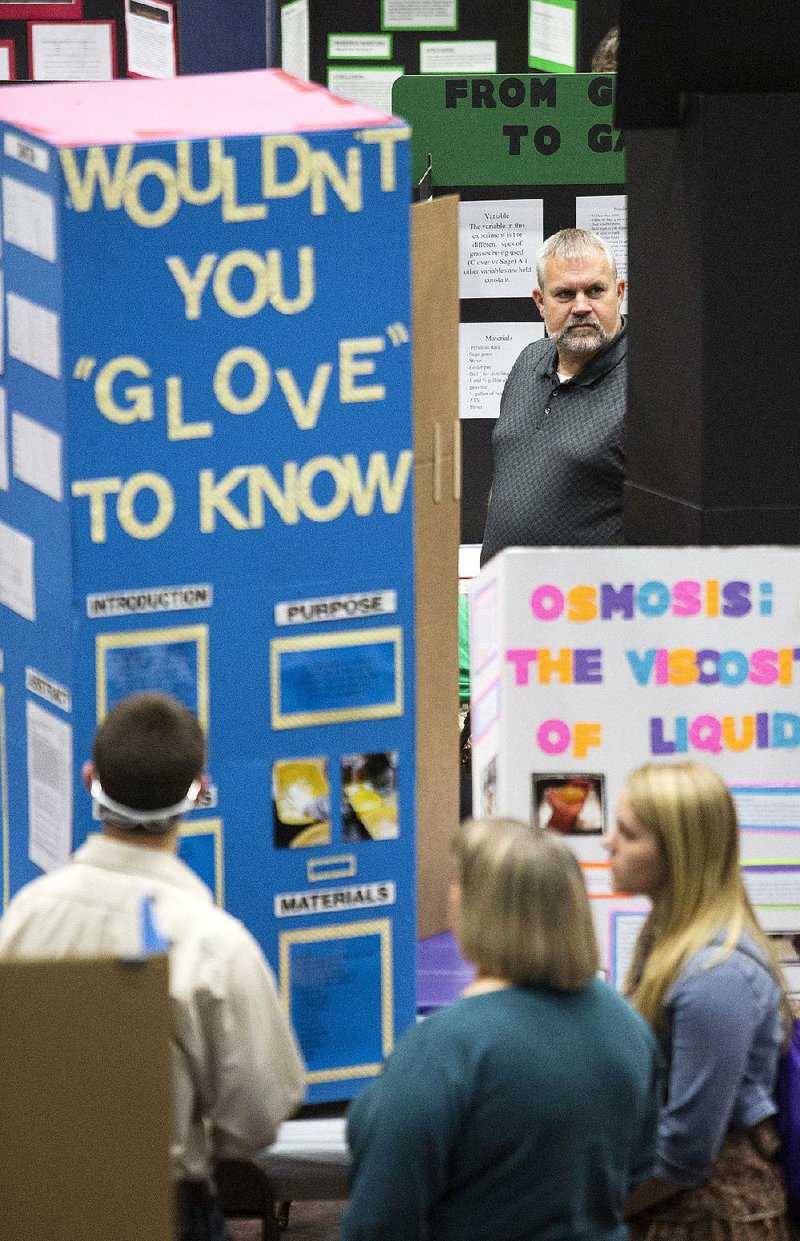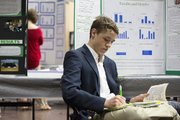CONWAY -- The bionic hand fashioned by 14-year-old Destany Ballard can hold and pick up objects that are as heavy as 2 pounds.
Relying on rubber bands, sturdy plastic bars and a simple system of pulling the two with a chain, the mechanical hand can be made at home at a low cost, Destany said, which could help a person who can't afford higher-technology prosthetics.
Destany, a freshman at Buffalo Island Central High School in Monette in northeast Arkansas, presented the hand Saturday at the Arkansas State Science and Engineering Fair held at the University of Central Arkansas in Conway. She was among about 250 high school students who displayed their theories and inventions.
Students mingled with new friends and their parents on the Jeff Farris Health and Physical Education Center gym floor, which was covered Saturday in tables and colorful tri-fold poster boards. The students ate cookies and awaited a decision about who would be selected to take part in the national science fair competition later this year.
The projects spanned the vast imaginations of Arkansas high school students: a behavioral study of what motivated people to sleep more hours at night, a somewhat stomach-turning study on the decomposition of ants and their release of oleic acid, and the ambitious "Enhancement of the Photocurrent Response of Tungsten Nano-Structures Using an Indium Oxide Coating," a project undertaken by three Little Rock Central High School students.
The event also had a robot, designed to follow lines and make turns while propelling itself.
Destany came up with the idea for a bionic hand last year after realizing that many soldiers return from combat having lost limbs. Concerned about the cost of replacing limbs, Destany decided to see what she could do to help.
"People spend a lot of money on hands," she said.
Since January, Destany has spent Tuesdays and Thursdays after school constructing the hand. Next year, Destany wants to create a voice-command system that would trigger the mechanical fingers to move.
Other science and engineering fair entrants have spent multiple years putting together their projects.
Ciana Casey, an 18-year-old Lonoke High School senior, spent two years trying to come up with a cheaper and easier way to examine and photograph specimens at a magnified level. Cameras and microscopes can be expensive, Ciana said, and the equipment in schools doesn't always work.
So Ciana attached a 10x magnifying lens to her smartphone's 4x camera, which she can use to photograph specimens over a flat-surfaced, portable light source.
Ciana hopes to turn the invention into a scholarship-winner, as she prepares to major in biology at Arkansas Tech University in Russellville next year and begin a career in medicine.
"I need money for college really bad," she said.
Jacob Andersen, a 17-year-old junior at Pulaski Academy, has spent two years on his project using liverwort -- an aquatic plant that grows in Arkansas -- to clean oil from water sources.
Jacob used to live in Pine Bluff, where he noticed oil from a raised highway dripping into a pond whenever it rained. He wanted to clean up the pond as his Eagle Scout project.
Jacob and two University of Arkansas at Pine Bluff professors stumbled onto liverwort, which also has recently been used to clean fish tanks.
Jacob said his research shows that the plant works and that it's sustainable, cheap and easy to get in Arkansas.
Evan Buckner, a 15-year-old sophomore at Pine Bluff High School, studied two kinds of soybean seeds to see if one was better at resisting a common plant pathogen that destroys seeds before they germinate.
He took treated and untreated HBK5521 and Hutchinson soybean seeds, then exposed some to the Pythium pathogen.
The result was just the start of Evan's enthusiasm for plant biology and agricultural sciences.
He dreams of working in the plant sciences department at Cornell University in Ithaca, N.Y., which he said is one of the best in the country.
Although Cornell is more than 1,000 miles away from Pine Bluff, Evan's inspiration comes from home, where people he knows are affected by the Pythium pathogen.
"I have a lot of family and friends who are farmers," he said. "Agriculture is big in Pine Bluff."
Until Cornell, Evan plans to test more soybean seed varieties next year for his junior year science fair project, getting a better idea of which soybean seeds would be better for farmers to use in the future.
Metro on 04/05/2015


